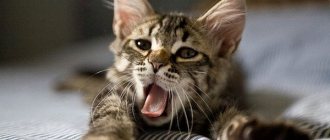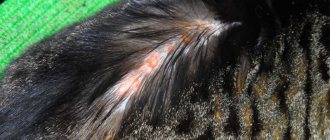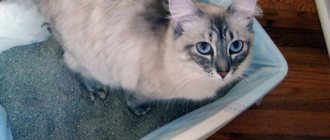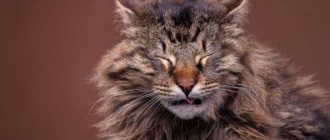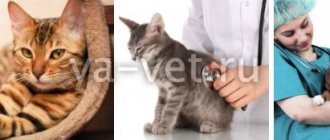Coronavirus in cats is a serious and dangerous disease, against which scientists have been struggling to create vaccines for decades. The peculiarity of this virus is that it can occur either in an acute form, leading to a quick and painful death, or in an asymptomatic form, which does not cause discomfort to the pet. Despite the fact that the causative agents of the disease die very quickly in the external environment, they can linger for a long time in a recovered host, posing a threat to other animals. We will talk about what means you can use to fight coronavirus below.
Coronavirus in cats
What is coronavirus
Feline coronavirus or Feline Coronavirus (FCoV) got its name due to its resemblance to the crown. The description of the appearance was made from a photograph obtained under microscopy.
There are many types of coronavirus, and today it is impossible to determine exactly which one the cat was infected with. While one type of virus causes only diarrhea, others cause dangerous illnesses, often fatal. Genetically, viruses are not different from each other, but have different biological characteristics.
Based on their ability to cause pathologies, feline coronaviruses are divided into 2 groups:
- Enteric coronavirus (FCoV). Safe. Causes mild enteritis (inflammation of the small intestine).
- Infectious peritonitis virus (VIPK, FIP, FIP). Highly dangerous strains.
Feline enteritis coronavirus affects the small intestine, causing diarrhea, but may not show symptoms for a year or more. Kittens are most susceptible when they are 1-2 months old. The disease begins with vomiting, then diarrhea joins. As a rule, after 2-4 days the animal recovers. Some owners do not even have time to notice that the pet is sick, and diarrhea is associated with food or overeating. At the same time, animals remain carriers of the virus for quite a long time and easily infect other cats if they share the same tray with them (through feces).
Infectious peritonitis is a dangerous disease that in most cases ends in death. It is caused by a specific strain of virus, but feline intestinal coronavirus can also mutate to FIP. The virus infects white blood cells, which directly affect the body’s immune defense, which becomes open to various infections.
The causative agent of enteritis and peritonitis is the same, but the diseases are completely different.
Main symptoms and signs
The incompletely understood appearance of the strain makes it difficult to quickly identify the problem. Even an experienced veterinarian, when diagnosing a disease, can be confused due to the large number of symptoms. Because of this, conclusions that are not always correct are often made. Sometimes the owner needs to insist on involving several qualified specialists in the identification and examination, who can confirm or refute the previously received diagnosis.
Incubation period
Unfortunately, neither the owner nor the doctor is able to notice the coronavirus while it is at the initial stage of development. The incubation period does not involve any external manifestations, and it can last from two weeks to one month.
The only way to detect the disease at an early stage is to get tested. Diagnosis at a veterinary clinic is strongly recommended in the following cases:
- the indoor cat met his street brothers;
- you moved into a house where other animals previously lived;
- you took another cat or dog into your home (then it is better to examine all the animals at once);
- the domestic cat has been outside, had contact with suspicious objects, marks of other cats;
- If the cat regularly goes outside, it is better to get tested quarterly.
Such a strict, at first glance, check will protect your pet not only from coronavirus, but also from other, no less dangerous and unpleasant diseases.
First manifestations and symptoms
As soon as the incubation period ends, a severe stage of the course begins. It is expressed by one or more signs. Their list is very extensive:
- lack of appetite;
- frequent vomiting, diarrhea with blood or mucus;
- weakness, depression;
- alternation of high and low body temperature;
- unexpected attacks of aggression, panic, inappropriate behavior;
- fear of light, search for a shaded room;
- change in color of the oral mucosa and gums from red to light blue;
- germination of blood vessels in the cornea;
- bloating of the abdominal cavity due to accumulated fluid;
- decline in immunity at the cellular level.
The wide variety of manifestations is explained by mutations of infected cells. Not all signs occur even with the highly pathogenic form of coronavirus in cats. How many there will be depends on each specific case. For example, an asymptomatic appearance does not entail any consequences visible to the owner. A mild form suggests a gastrointestinal disorder, which is associated with poisoning or overeating.
The most terrible subtype develops gradually. It all starts with digestive problems, then the cat’s kidneys, liver and nervous system are affected, causing painful, hard-to-bear cramps.
How is coronavirus transmitted in cats?
At the initial stage of infection, the virus is released in saliva. Animals become infected by eating from the same bowl or by licking each other. But the main route is through the feces of sick cats and carriers. In 1 g. stool contains billions of viral particles. Animals become infected through airborne droplets, ingesting or inhaling the virus. The infection can be transmitted to cats through human clothing and shoes soiled with contaminated feces.
Coronavirus infection is a highly contagious disease. A small particle of litter from an infected cat's litter box is enough to infect others.
In kittens, the infection appears more often at the age of 5-7 weeks, when there are few protective antibodies in the mother’s milk, and their immunity has not yet strengthened. Infection of the fetus when the infectious agent penetrates the placenta is isolated cases. Also, there are no viral particles in the female’s milk.
How can an animal become infected?
global $ads_google; //data-ad-slot=”2475549904″ $ads_google = empty($ads_google) ? false : true; ?> if ($ads_google == false) {?>
$ads_google = true; ?> } ?>
The infection is contagious, therefore, among all sources of infection, the virus-carrying animal takes first place. It doesn't matter whether he shows symptoms or not. In this regard, any accumulation of cats on the street, nurseries, shelters, and even accidental contact with a sick individual pose a danger.
Indirect communication through shared care items also plays a role. The source of the coronavirus can be food and water bowls, a tray, and beds. They contain saliva or traces of excrement through which the microbe is transmitted. After a sick cat, the virus lives on objects for another 24 hours, after which it is destroyed. Eating the feces of relatives on the street is also a risk factor for cats, since the coronavirus remains viable in them for much longer - up to several months.
The path of the virus in the cat's body
When a virus enters the body, there are 4 possible development paths:
- In 4% of animals, the immune system immediately fights the virus. They are healthy and do not release the virus into the external environment.
- Some are asymptomatic carriers - the cat’s life is not in danger, but he is a lifelong carrier, sheds the virus in his feces and infects others. These animals are healthy but may suffer from chronic diarrhea. This category accounts for 13% of those infected.
- In the body, the virus selects the tonsils and small intestine for reproduction. May not manifest itself for any time. The immune system is struggling. In most cases, the infection goes away. The virus is eliminated from the body, which takes from several weeks to 9 months. On average - 1 month.
- Under the influence of some reasons (it is still not known exactly what) in 10% of infected cats, the virus mutates and becomes pathogenic (dangerous). Most researchers are inclined to believe that the cause of the mutation is related to stress. The virus attacks the immune system. When macrophages and lymphocytes (the main defenders of the immune system) are affected, the virus spreads throughout the body. It is not tied to one organ. Especially a lot accumulates in the liver, spleen and other organs, where there are many blood vessels. With weak immunity, the walls of small vessels are damaged and blood seeps into the cavities, the largest of which is the abdominal cavity. Wet peritonitis occurs. If the immune system fights back, dry peritonitis begins. With any form of infection, immune cells die. The body is not protected and has no chance of survival. Therefore, the disease is considered similar to AIDS and viral leukemia. Ends with the death of the animal.
If a cat is a carrier, then the greatest likelihood of developing FIP occurs before the age of 1 year. In adult pets, even if they have antibodies to enteric coronavirus, the risk is unlikely.
Who's at risk
High susceptibility from 3 months to 3 years. Coronavirus infection is rarely diagnosed in older cats. Sometimes a chronic form of FECV is detected.
The disease spreads quickly in crowded conditions. The probability of infection of individuals in a small area when a coronavirus hits is from 70 to 100%. When the intestinal form of the pathogen mutates into a viral one, a massive outbreak of the disease occurs, threatening the lives of almost all cats.
FECV infection occurs due to poor hygiene and disinfection of rooms and cells. When the intestinal form mutates and the pathogen begins to multiply in macrophages, viral peritonitis develops.
Symptoms of coronavirus infection
Coronavirus infection in cats can occur without symptoms. Or, on the contrary, it can manifest itself in a variety of clinical signs, which depends on the strength of the animal’s immunity.
Sign of enteritis
Viral enteritis occurs more often in kittens, especially after weaning. The first signs are noticeable 2-7 days from the moment of infection. It's mostly diarrhea. Viral enteritis is also manifested by the following symptoms:
- impurities of mucus and blood in the stool;
- poor appetite;
- slow weight gain;
- temperature.
If there is no additional disease, the symptoms do not require treatment and go away on their own. It’s just important to consider: if a kitten has diarrhea, loss of appetite and a positive test for coronavirus, this does not mean that the cause is coronavirus. You need to go to the clinic for diagnosis.
Causes of infection
We will dwell on this point a little more to better reveal the features of this disease. By the way, sometimes the clinical picture is not clear, as we described above, but blurred. For several days, the animal may be lethargic, eat poorly or completely refuse food, but the cat does not experience diarrhea or vomiting, which means the suspicion of coronavirus does not fall. As a result, by the time symptoms clear up, it may already be too late. Therefore, it is very important to receive veterinary services in a good clinic, where experienced doctors work.
Veterinary experts have been researching this disease for a very long time. During these studies, it was found that quite often the coronavirus is found in a dormant state in the intestines of felines. If conditions suitable for the virus arise, it takes on an aggressive form and causes inflammation of the intestines, or even mutates. Moreover, in most cases, risk groups are young animals and cats who have reached 11-12 years of age. Veterinarians are trying to find out what exactly is the trigger for the onset of the development of the disease, but the number one task is to identify the genetic or other characteristics of the body that allow the individual to remain completely immune to the virus. This would open a new chapter in the history of veterinary medicine.
Diagnosis of coronavirus in cats
Today there is not a single reliable test that can determine the presence of viral peritonitis. All show only the quantitative expression of the virus (titers).
Diagnosis of coronavirus infection is carried out comprehensively:
- General blood analysis. Shows the number of titles. Does not provide information about the severity of the infection.
- Blood ELISA. It will show antibodies, but not where they are located.
- Immunochromatography or ICA diagnostics is an express test, the results of which are ready in 5-10 minutes. The test detects both antigen (foreign cells) and antibodies (immune response). The kit contains everything you need, so the cat owner can conduct the research himself. This test is used when buying a kitten and mating. It is enough to apply animal feces to a special strip, and in a few minutes you will get the result. Positive result – the cat is dangerous to other animals. A negative result still does not exclude carrier status. In laboratories, blood is examined using ICA.
- Polymerase chain reaction or PCR. Feces are examined. If 4 tests with an interval of 7-10 days show negative results, the cat is considered to be free of infection.
- Ultrasound of the abdominal cavity.
If dry peritonitis is suspected, an eye examination is performed, since damage to the organ of vision may be the only manifestation of dry IPC. It is important for the doctor to rule out diseases such as viral leukemia, toxoplasmosis, and viral immunodeficiency in the cat.
In the case of a wet form of infection, other diseases that can cause dropsy are excluded: cirrhosis of the liver, heart failure, purulent pleurisy, cholangitis.
Vaccination
For mild forms of the disease, the intranasal American vaccine Primucell from Pfizer is used. However, by 4 months, when the first vaccination in kittens becomes possible, most of them are already infected or have had contact with a virus carrier, so vaccination becomes ineffective.
For infectious peritonitis, the vaccine does not work.
What to do if the test is positive
The virus can be detected in both sick and healthy cats.
Priority measures:
- Don't panic. It is not at all necessary that FIP will develop.
- Isolate other domestic cats. This is not always possible. But the owner can provide each pet with a separate tray, provide several scoops for cleaning trays, and individual bowls. The feeding area should be as far away from the toilet room as possible.
- Refuse mating, exhibitions, etc.
- Review your pet's diet. Switch to dietary nutrition.
- It is imperative to eliminate stress for 1-2 months and, if possible, not carry out activities that can cause stress - haircuts, scheduled sterilization or castration operations.
Where did the coronavirus come from: COVID-19 infection
Scientists can only guess where the coronavirus, which was later named COVID-19, came from. But the most likely version of its appearance indicates a mutation of an infection of animal origin. Pangolins and bats are carriers of a virus that is 90% similar in its genome to humans, which presumably first appeared in China, in one of the markets in Wuhan province. There is a version among scientists that the animal strain of coronavirus mutated in the bodies of people who ate contaminated bat meat.
Question to the expert
Can a cat infect me with the new coronavirus COVID 2020?
Until recently, no cases of COVID 2020 or 2019-nCoV had been identified in domestic cats or any other feline species. But recent news is increasingly reporting that a new type of coronavirus infection has been detected in the blood of several animals at once. However, there is no convincing evidence yet that cats can infect humans with Covid-19, even if they themselves have it.
In the wake of the COVID-19 pandemic scare in 2020, cat owners are worried about whether their pets could become sick with a new type of infection or infect people. According to the latest research, the current strain of coronavirus does not pose a threat to owners of mustachioed pets.
Scientists know of only two strains that are transmitted to cats from other cats. These are FECV, which causes enteritis, gastroenteritis, and FIPV, which leads to infectious peritonitis. Both types are the most “classical” coronaviruses, in no way related to the Wuhan version. It is impossible to infect an owner or non-feline pet with these strains of the virus.
However, it should be taken into account that the coronavirus, like many other types of virus, changes very quickly, mutates, acquiring new qualities and adapting to changing conditions.
Treatment of coronavirus
There is no special drug that acts on FCoV. Only symptomatic treatment is carried out. Coronavirus enteritis is treatable. However, concomitant infections complicate therapy. Viral peritonitis has no cure. Treatment of concomitant manifestations is carried out - diseases of the liver, lungs, heart, nervous system. However, the animal dies. Some cats can live for several months. With the dry form, a cat can live up to a year.
Treatment with immunomodulators only worsens the pet's condition. The number of viral cells increases. Therefore, doctors, on the contrary, suppress the immune system by treating with prednisone.
It is expected that the study and development of drugs against human coronavirus infection will open up prospects for new ways to treat coronavirus in cats.
Forms of the virus
The course of the disease directly depends on the bacteria that has entered the body of the individual. They build on it when prescribing medications and therapy. There are three options for the development of malaise:
- asymptomatic;
- easy;
- heavy.
First option
considered the most common. This strain poses a threat not to the carrier, but to domestic relatives living in the neighborhood.
Mild course
typical for adults. Infection with bacteria provokes the development of enteritis. Diarrhea, high fever, runny nose, eye inflammation, and vomiting accompany the disease. The animal experiences pain in the abdomen, and a white coating forms on the tongue. Coronavirus enteritis in cats combines symptoms of poisoning and colds.
Severe leakage
associated with a sharp deterioration in condition, loss of appetite, and vomiting. Weight loss begins, mucous membranes begin to turn pale. With the wet subtype, ascites develops - accumulation of fluid in the abdomen, dysfunction of the kidneys, liver, and vascular damage. Muscle tissue gradually loses elasticity, and cramps are possible due to disturbances in the functioning of the nervous system.
The dry subtype is characterized by a sharp decrease in weight, and in later stages – a problem with the functioning of internal organs. The infection often combines both types or one begins to mutate into the other.
Wet inflammation without proper treatment lasts for about six months, then becomes dry, causing the death of the pet. Dry peritonitis is considered chronic, slowly and over a long period of time destroying the cat’s body.
Prevention
The main measures to prevent feline coronavirus infection are as follows:
- The owner must ensure that the pet's gastrointestinal tract is healthy. Only in this way will the immune system be able to fight back even at the stage of introduction of the virus into the intestines.
- Do not keep a large number of cats in one room (no more than 6-10). When a new cat is born, the quarantine must be at least 3 months. If an animal is taken from a nursery, a test for FCoV with a seronegative (negative) result is desirable.
- Mothers with a positive reaction to the test should have their kittens removed before 4 weeks of age.
- Change the filler regularly and wash the trays thoroughly. Each cat should have its own litter box.
- It is advisable to use non-dusting filler. So that particles of feces do not spread throughout the house along with the filler.
- Monitor and treat your pet's concomitant diseases.
- Carry out deworming and anti-flea treatment of the animal.
Routes of infection
How is coronavirus transmitted in cats? One animal becomes infected with coronavirus enteritis from another, mainly through feces. A rare method of infection is transmission of the virus through saliva. The possibility of spreading the virus by air has not been confirmed. FIPV generally multiplies and lives in blood cells, not intestinal cells, and therefore cannot be excreted in feces or saliva. Infectious peritonitis occurs as a consequence of infection with enteritis coronavirus, which then mutates into a form that affects blood cells. Coronavirus enteritis, not FIPV, is transmitted from one cat to another through feces.
A short video about how coronavirus is transmitted:
Is coronavirus transmitted to humans and animals?
Feline coronavirus infection is harmless to people and other pets. Only cats that come into contact with a carrier or a sick animal can “catch” the infection. Pet owners need not worry: they are not at risk of contracting coronavirus.
Stability of coronavirus in the external environment
The coronavirus is extremely unstable in the external environment. Animal viruses lose activity outside the host within 24 hours. You can deal with them by heating and using disinfectants. The virus remains stable at low temperatures and low pH levels. It is also resistant to phenols.
The virus does not like dry surfaces and is destroyed when the external temperature rises. To prevent the disease, promptly carry out hygienic treatment of bowls and disinfection of the toilet, exclude contact between the cat and infected animals and street walks.
Is it possible to treat at home?
The detected coronavirus is not a reason to panic. A cat can live with it all its life without any symptoms. It is not the coronavirus infection that is dangerous, but the mutation that leads to death. The cat owner cannot somehow influence or prevent its occurrence. The development of events depends on the pet’s immunity and how many viruses have settled in the cat’s body.
Taking a drug that strengthens the immune system will also not affect the situation. Most cats clear the virus on their own. If this had not happened, the mortality rate would have been much higher. It is important not to stress your cat. Forced treatment (which is known to be ineffective) is stressful and means an increased risk of FIP. In any case, all vitamins and immunomodulatory drugs should be used under the supervision of a physician.
Symptoms of FIP in cats
The virus that causes IPC is referred to in the international classification as FIPV and is capable of causing various manifestations of damage to many organs and systems in the body of cats.
The name of the disease is due to the fact that often one of the main clinical signs is peritonitis.
It is accepted to divide the course of IPC into three main forms:
- Wet IPC. In this form of peritonitis, due to damage to the blood vessels of the peritoneum or pulmonary pleura, exudate effusion occurs into the abdominal or thoracic cavity. The development of wet peritonitis is provoked by a weak immune reaction of the body; this form of the disease occurs mainly in kittens. The disease is accompanied by fever up to 40 C, weakness, lack of appetite, peritonitis, with accumulation of effusion in the abdominal cavity, and gradual exhaustion.
When effusion forms in the chest cavity, the disease is accompanied by breathing problems and wheezing.
If the animal does not die in the first weeks, then signs of peritonitis or breathing problems are accompanied by symptoms of renal and liver failure, manifestations of pancreatic dysfunction.
The duration of the wet form of infectious peritonitis is about 6 months. The outcome is fatal, or the disease develops into the form of dry IPC.
- The dry form of peritonitis is characterized by the absence of effusion fluid. This form of peritonitis affects older cats. The disease occurs without pronounced symptoms. A decrease in appetite and physical activity may be noted. With this form, diagnosing the disease is very difficult, this is explained by the absence of pronounced clinical signs. In a later period, multiple signs of damage to internal organs appear, most often the liver and kidneys, less often the nervous system (weakness of the hind limbs, paralysis, paresis, convulsions, behavioral disorders - aggression or apathy) and eyes (hyphema, retinitis, iridocyclitis).
- Hidden form. It is characterized by a long course without the manifestation of any clinical signs. In the latent form, only blood macrophages are affected and the animal can be a virus carrier for a long time without showing signs of the disease. Periodically releasing the virus into the environment, the cat, which is a virus carrier, infects healthy animals.
In the latent form, the animal’s body either gets rid of the virus over time, or, if the immune system is weakened, the disease progresses. Viruses from immune blood cells penetrate the internal organs, where characteristic granulomatous nodules and compactions develop.
The dry form of the disease can turn into a wet one, or they occur simultaneously.

